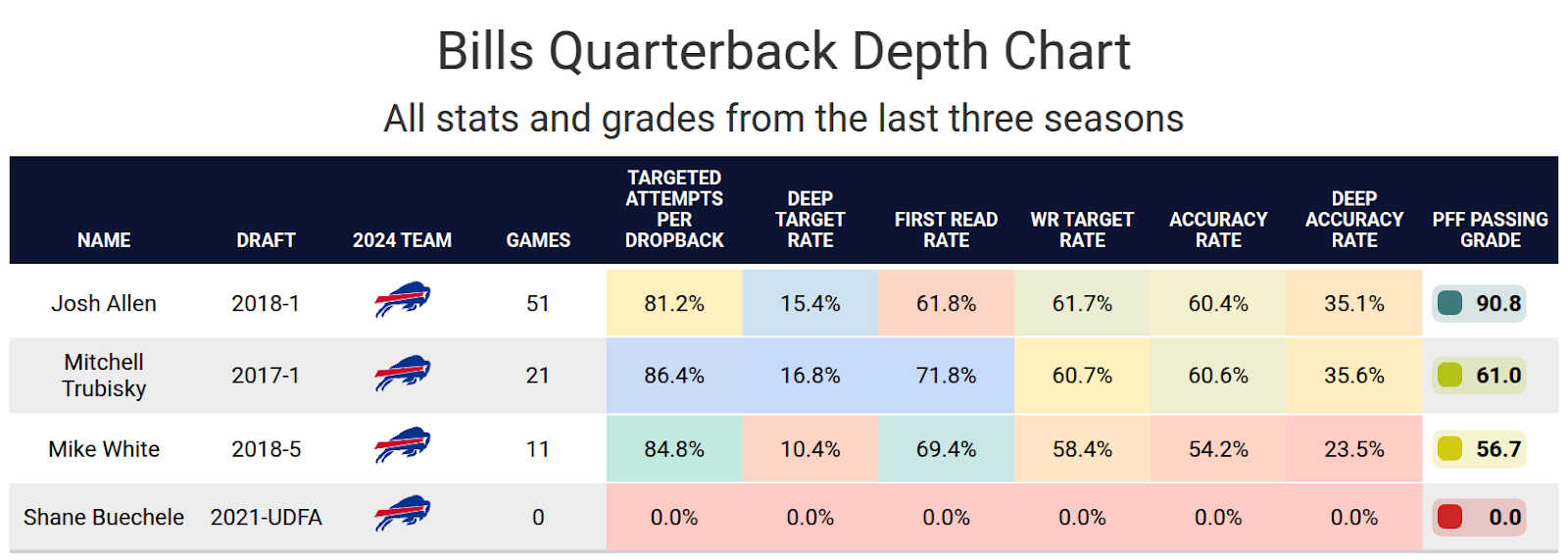- Keon Coleman shows some sparks: Coleman was a fantasy starter over the course of October, but then a wrist injury cost him a month, and his production never recovered.
- Coleman remains the Buffalo Bills’ field stretcher: Coleman was among the league leaders in average target depth and deep target rate last season.
- Subscribe to PFF+: Get access to player grades, PFF Premium Stats, fantasy football rankings, all of the PFF fantasy draft research tools and more!
Estimated Reading Time: 5 minutes

PFF’s Fantasy Football Player Profile series delivers the most in-depth fantasy football analysis available for the 2025 season.
Using PFF’s exclusive data, we evaluate player performance, competition for touches and how teammates and coaching staffs
Last updated: 7:15 a.m. Wednesday, June 11
Player performance
The Buffalo Bills decided to completely rework their wide receiver room after the 2023 season. Stefon Diggs, Gabe Davis, Trent Sherfield and Deonte Harty all moved on, so Khalil Shakir was the lone incumbent receiver. The team added free agents Curtis Samuel, Mack Hollins and Marquez Valdes-Scantling in addition to drafting Keon Coleman with the 33rd pick of the 2024 NFL Draft.
Coleman was instantly put into the Bills' starting lineup as their X receiver, and he had a fine debut with four receptions for 51 yards. He followed that up with no receptions in Week 2 despite playing in 91% of the Bills' offensive snaps. The following week, he was benched for the first quarter due to a tardiness issue and similarly didn’t play in the third quarter.
While Coleman returned to the starting lineup in Week 4, he didn’t reach 85% of the team's offensive snaps again until Week 17. From Weeks 4-8, Coleman never had a high target rate, but he caught a lot of big passes. He scored the 21st-most fantasy points during that stretch with 12.0 points per game. His only 100-yard game was in Week 7 against the Tennessee Titans, when he caught four passes for 125 yards. He caught a season-high five receptions for 70 yards and a touchdown the following week.
Coleman suffered a wrist injury in Week 9, which caused him to miss the following four weeks of the season. While Coleman was off the injury report after Week 15, he never returned to being the same player he was in October. He was held to one reception in five of his final seven games, including the playoffs. In the other two games, he caught three passes for 27 yards and a touchdown and two receptions for 31 yards.
Coleman’s play particularly stood out against man coverages, as 25% of his receptions against man resulted in touchdowns, the sixth-best rate among wide receivers. He avoided 0.33 tackles per reception against man, second-best.


Projected role
The Bills made some changes at wide receiver, but nothing that should have a major impact on Coleman. They moved on from Hollins and Amari Cooper and brought in Joshua Palmer and Elijah Moore. Initially, Valdes-Scantling was Coleman’s backup, followed by Cooper. Both Palmer and Moore are Z and slot receivers. Coleman has no obvious backup. It could be a combination of players who give Coleman a rest. However, the team not having a clear backup who can directly replace Coleman is a good sign of confidence in the young receiver.
Coleman’s 33.9% deep target rate was the fourth-most among wide receivers with at least 50 targets, while his 15.5-yard average depth of target was the fifth-highest. Typically, players with that high of an average target depth and deep target rate aren’t players who can be fantasy starters. D.K. Metcalf and George Pickens are the two most notable receivers with a slightly lower average target depth and deep rate. Coleman doesn’t quite have the same speed as those players, but those are the kinds of players Coleman can ideally become.


Impact of teammates
Coleman will be in his second season with Joe Brady as his offensive coordinator and Josh Allen as his quarterback. The Bills have a high-scoring offense where Allen is willing to throw deep, which is a big reason Coleman should be considered for fantasy drafts despite his inconsistent play last season.
The problem is that Brady’s offensive philosophy has been to spread the ball around to everyone on the offense. That was a big reason Stefon Diggs averaged 86 yards per game before Brady became offensive coordinator in 2023, and 45 yards per game after Brady took over. Nine different players had 25 or more targets last season, while no one had more than 95. While Shakir was the top receiver with 76 receptions, everyone else was between 17 and 44. The way that Coleman has been used already generally restricts a player's target share. While there is still room for him to receive more targets. There is likely a ceiling on his fantasy production as long as Brady continues having this philosophy.


Bottom line
Keon Coleman couldn’t be relied on for fantasy football purposes for most of last season. He’s expected to improve, given his draft capital and lack of competition for playing time. He is not someone you’ll be able to start every week because he will have some excellent weeks and some quiet ones, but you can be more confident in playing him against a defense that uses a lot of man defense.

Footnotes
- Statistics in tables and charts were chosen based on their ability to predict future fantasy performance on a per-game or per-opportunity basis or to describe the player relative to others at the same position.
- “Opportunities” are defined as passing dropbacks, rushing attempts and routes run as a receiver.
- Numbers are provided either by season or based on the past three years. For rookies, only college statistics are included. For non-rookies, only NFL statistics are considered, regardless of whether they played in college within the previous three years.
- As college competition is easier than NFL competition, most rookies are likely to see a decline from their historical numbers.
- Only FBS data is considered for college players and comparisons.
- Kneel-downs are removed from rushing data to provide cleaner quarterback rushing rate statistics.
- The table colors in this article range from blue (indicating good/high) to red (indicating bad/low).
- All percentiles and color codings compare the given player to others with a high sample of opportunities. Generally, the cutoff is one-third of the possible opportunities in the sample. If a player does not meet the threshold, they are still included in the comparison, though their results may appear better or worse than expected due to the smaller, less predictive sample size.
- Information on utilization classifications and their importance can be found here for running backs, wide receivers and tight ends.



 © 2025 PFF - all rights reserved.
© 2025 PFF - all rights reserved.